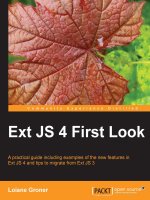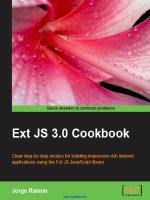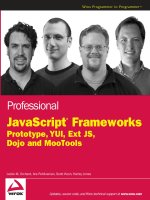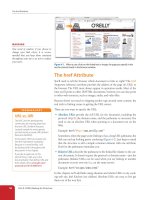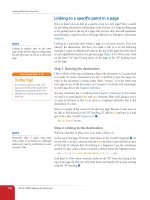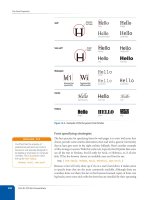Learning Ext JS ppsx
Bạn đang xem bản rút gọn của tài liệu. Xem và tải ngay bản đầy đủ của tài liệu tại đây (6.57 MB, 324 trang )
Learning Ext JS
Build dynamic, desktop-style user interfaces for your
data-driven web applications
Shea Frederick
Colin Ramsay
Steve 'Cutter' Blades
BIRMINGHAM - MUMBAI
This material is copyright and is licensed for the sole use by lawrence rambert on 16th June 2009
2012 price st, , rahway, , 07065
Learning Ext JS
Copyright © 2008 Packt Publishing
All rights reserved. No part of this book may be reproduced, stored in a retrieval
system, or transmitted in any form or by any means, without the prior written
permission of the publisher, except in the case of brief quotations embedded in
critical articles or reviews.
Every effort has been made in the preparation of this book to ensure the accuracy of
the information presented. However, the information contained in this book is sold
without warranty, either express or implied. Neither the authors, Packt Publishing,
nor its dealers or distributors will be held liable for any damages caused or alleged to
be caused directly or indirectly by this book.
Packt Publishing has endeavored to provide trademark information about all the
companies and products mentioned in this book by the appropriate use of capitals.
However, Packt Publishing cannot guarantee the accuracy of this information.
First published: November 2008
Production Reference: 1201108
Published by Packt Publishing Ltd.
32 Lincoln Road
Olton
Birmingham, B27 6PA, UK.
ISBN 978-1-847195-14-2-14-214-2
www.packtpub.com
Cover Image by Michelle O'Kane ()
This material is copyright and is licensed for the sole use by lawrence rambert on 16th June 2009
2012 price st, , rahway, , 07065
Credits
Authors
Shea Frederick
Colin Ramsay
Steve 'Cutter' Blades
Reviewer
James Kennard
Senior Acquisition Editor
David Barnes
Development Editor
Swapna V. Verlekar
Technical Editor
Gagandeep Singh
Copy Editor
Sumathi Sridhar
Editorial Team Leader
Akshara Aware
Project Manager
Abhijeet Deobhakta
Project Coordinator
Neelkanth Mehta
Indexer
Monica Ajmera
Proofreader
Dirk Manuel
Production Coordinator
Rajni R. Thorat
Cover Work
Rajni R. Thorat
This material is copyright and is licensed for the sole use by lawrence rambert on 16th June 2009
2012 price st, , rahway, , 07065
About the Authors
Shea Frederick began his career in web development before the term 'Web
Application' became commonplace. By the late 1990s, he was developing web
applications for Tower Records that combined a call center interface with inventory
and fulllment. Since then, Shea has worked as a developer for several companies,
building and implementing various commerce solutions, content management
systems, and lead tracking programs.
Integrating new technologies to make a better application has been a driving
point for Shea's work. He strives to use open-source libraries, as they are often the
launching pad for the most creative technological advances. After stumbling upon a
young user interface library called yui-ext several years ago, Shea contributed to its
growth by writing documentation, tutorials, and example code. He has remained an
active community member for the modern yui-ext library—Ext JS. Shea's expertise
is drawn from community forum participation, work with the core development
team, and his own experience as the architect of several large Ext JS-based web
applications. He currently lives in Baltimore, Maryland, with his wife and two dogs,
and spends time skiing, biking, and watching the Steelers.
A big loving thanks goes out to my wife Becky for looking over my
shoulder to correct the many grammatical errors my ngers produce,
and for always being there to support me.
Colin Ramsay began his career building ASP websites as a part-time developer
at university. Since then, he's been involved with a range of web technologies
and employers in the North East of England, working on everything from ash-
in-the-pan web frameworks to legacy applications. Most recently, he has used
this experience to provide a springboard for the formation of his UK-based web
development company, Plastiscenic Limited. From writing articles and blog posts
across the web, Colin has made the leap to book authoring with the patience and
kind assistance of his friends and family.
This material is copyright and is licensed for the sole use by lawrence rambert on 16th June 2009
2012 price st, , rahway, , 07065
Steve Blades (who goes by the name of 'Cutter'), a �irginia native, raised ina �irginia native, raised in
Georgia, began his computing career when he started learning BASIC at age
12, hammering out small programs on a Timex Sinclair 1000. As a linguist and
Intelligence Analyst for the US Army, Cutter began learning HTML while stationed
at the National Security Agency. On leaving the service, Cutter became part-owner
of a growing Advertising Specialty company, developing business automation
processes for the company by writing MS Ofce-based applications. From there,
Cutter went on to become a Customer Support Technician with a local Internet
Service Provider. Upon showing programming aptitude, he was later moved
into their Corporate Support department, providing maintenance and rewrites to
existing websites and applications. It was here that Cutter began to really dive into
web application programming, teaching himself JavaScript, CSS, and ColdFusion
programming. Cutter then took the position of IT Director for Seacrets, a large resort
destination in Ocean City, Maryland, while also holding the same position for one
of its owner's other companies, Irie Radio. Now, Cutter is the Senior Web Developer
for Dealerskins, a company that develops and hosts websites for the automobile
dealership industry. He lives and works in Nashville, Tennessee with his wife Teresa
and daughter Savannah.
Apart from work, side projects, and maintaining his blog (http://blog.
cutterscrossing.com), Cutter also enjoys spending time with his family, is an avid
reader and a videophile, and likes to relive his band days with a mic in hand.
I would like to thank a few people for their support while I have
been working on this project. First, thanks to Jack Slocum and
the entire Ext JS team for giving us such a great library to write
about. Thanks to the Dev Team at Dealerskins for helping proof
my chapters. Thanks to my Mom, for buying me my rst book on
programming. But, most of all, thanks to my wife, Teresa, and my
daughter, Savannah, for giving me the time, space, love, and
support needed to work on this project. I could never have done
it without them.
This material is copyright and is licensed for the sole use by lawrence rambert on 16th June 2009
2012 price st, , rahway, , 07065
About the Reviewer
James Kennard is an all-round computer specialist with a particular interest in
web-based technologies. He authored the Joomla! CMS book Mastering Joomla! 1.5
Extension and Framework Development. He holds a B.Sc. in Computer Science and has
worked for organisations such as LogicaCMG. James has recently taken an interest
in user interfaces and overall UX—it is this which led him to the truly superb
Ext JS project.
This material is copyright and is licensed for the sole use by lawrence rambert on 16th June 2009
2012 price st, , rahway, , 07065
This material is copyright and is licensed for the sole use by lawrence rambert on 16th June 2009
2012 price st, , rahway, , 07065
This material is copyright and is licensed for the sole use by lawrence rambert on 16th June 2009
2012 price st, , rahway, , 07065
Dedicated to our family, friends, and the Ext JS team.
This material is copyright and is licensed for the sole use by lawrence rambert on 16th June 2009
2012 price st, , rahway, , 07065
This material is copyright and is licensed for the sole use by lawrence rambert on 16th June 2009
2012 price st, , rahway, , 07065
Table of Content
Preface 1
Chapter 1: Getting Started 9
About Ext 9
Ext: Not just another JavaScript library 11
Cross-browser DOM (Document Object Model) 12
Event-driven interfaces 12
Ext and AJAX 12
Getting Ext 13
Where to put Ext 13
Including Ext in your pages 14
What do those files do? 15
Using the Ext library 15
Time for action 16
The example 17
Not working? 17
Adapters 18
Using adapters 18
I'm asynchronous! 19
Localization 20
English only 20
A language other than English 21
Multiple languages 21
Ext JS online community 22
Summary 22
This material is copyright and is licensed for the sole use by lawrence rambert on 16th June 2009
2012 price st, , rahway, , 07065
Table of Contents
[ ii ]
Chapter 2: The Staples of Ext 23
Ready, set, go! 23
Spacer image 24
Widget 24
Time for action 24
What just happened? 25
Using onReady 25
More widget wonders 26
Meet JSON and the config object 28
The old way 28
The new way—config objects 28
What is a config object? 29
How does JSON work? 30
Time for action 30
Lighting the fire 32
The workhorse—Ext.get 33
Speed tip 34
Summary 35
Chapter 3: Forms 37
The core components of a form 37
Our first form 38
Nice form—how does it work? 39
Form fields 39
Validation 40
Built-in validation—vtypes 41
Styles for displaying errors 43
Custom validation—create your own vtype 44
Masking—don't press that key! 45
Radio buttons and check boxes 46
It's not a button, it's a radio button 46
X marks the check box 46
The ComboBox 47
Database-driven ComboBox 47
TextArea and HTMLEditor 50
Listening for form field events 51
ComboBox events 51
Buttons and form action 53
Form submission 53
Talking back—the server responses 54
This material is copyright and is licensed for the sole use by lawrence rambert on 16th June 2009
2012 price st, , rahway, , 07065
Table of Contents
[ iii ]
Loading a form with data 56
Static data load 56
Object reference or component config 58
Instantiated 58
Component config 58
Summary 59
Chapter 4: Buttons, Menus, and Toolbars 61
A toolbar for every occasion 61
Toolbars 61
The button 63
Menu 63
Split button 64
Toolbar item alignment, dividers, and spacers 65
Shortcuts 66
Icon buttons 66
Button handlers—click me! 67
Load content on menu item click 68
Form fields in a toolbar 69
Toolbars in windows, grids, and panels 70
Summary 71
Chapter 5: Displaying Data with Grids 73
What is a grid anyway? 74
Displaying structured data with a GridPanel 74
Setting up a data store 75
Adding data to our data store 75
Defining your data for the data store 76
Specifying data types 77
Displaying the GridPanel 78
How did that work? 80
Configuring the GridPanel 80
Defining a Grids column model 81
Using cell renderers 82
Formatting data using the built-in cell renderers 82
Creating lookup data stores—custom cell rendering 83
Combining two columns 84
Generating HTML and graphics 84
Built-in features 85
Client-side sorting 86
Hidden/visible columns 86
Column reordering 86
This material is copyright and is licensed for the sole use by lawrence rambert on 16th June 2009
2012 price st, , rahway, , 07065
Table of Contents
[ iv ]
Displaying server-side data in the grid 88
Loading the movie database from an XML file 88
Loading the movie database from a JSON file 90
Loading data from a database using PHP 91
Programming the grid 92
Working with cell and row selections 92
Listening to our selection model for selections 93
Manipulating the grid (and its data) with code 94
Altering the grid at the click of a button 94
Advanced grid formatting 95
Paging the grid 96
Grouping 98
Grouping store 98
Summary 100
Chapter 6: Editor Grids 101
What can I do with an editable grid? 101
Working with editable grids 102
Editing more cells of data 104
Edit more field types 104
Editing a date value 105
Edit with a ComboBox 106
Reacting to a cell edit 106
What's a dirty cell? 107
Reacting when an edit occurs 107
Deleting and adding in the data store 108
Removing grid rows from the data store 109
Adding a row to the grid 110
Saving edited data to the server 112
Sending updates back to the server 112
Deleting data from the server 114
Saving new rows to the server 115
Summary 117
Chapter 7: Layouts 119
What are layouts, regions, and viewports? 119
Our first layout 121
Splitting the regions 122
I want options 123
Tab panels 124
Adding a tab panel 124
This material is copyright and is licensed for the sole use by lawrence rambert on 16th June 2009
2012 price st, , rahway, , 07065
Table of Contents
[ v ]
Widgets everywhere 126
Adding a grid into the tabpanel 126
Accordions 128
Nesting an accordion layout in a tab 128
Placing a toolbar in your layout 129
A form to add new movies 131
Tricks and advanced layouts 132
Nested layouts 132
Icons in tabs 134
Programmatically manipulating a layout 135
Now you see me, now you don't 135
Give me another tab 136
Summary 136
Chapter 8: Ext JS Does Grow on Trees 137
Planting for the future 137
From tiny seeds 138
Our first sapling 138
Preparing the ground 139
A tree can't grow without data 140
JSON 141
A quick word about ID 141
Extra data 142
XML 142
Tending your trees 143
Drag and drop 143
Sorting 145
Editing 146
Trimming and pruning 147
Selection models 147
Round-up with context menus 148
Handling the menu 149
Filtering 150
The roots 151
TreePanel tweaks 151
Cosmetic 152
Tweaking TreeNode 152
Manipulating 153
Further methods 154
Event capture 155
This material is copyright and is licensed for the sole use by lawrence rambert on 16th June 2009
2012 price st, , rahway, , 07065
Table of Contents
[ vi ]
Remembering state 156
StateManager 156
Caveats 157
Summary 157
Chapter 9: Windows and Dialogs 159
Opening a dialog 159
Dialogs 160
Off the shelf 160
Confirmation 162
It's all progressing nicely 163
Roll your own 164
Behavior 165
Windows 166
Starting examples 166
Paneling potential 167
Layout 168
Configuration 169
When I'm cleaning windows 169
The extras 169
Desktopping 170
Further options 171
Framing our window 171
Manipulating 172
Events 173
State handling 174
Window management 175
Default window manager behavior 175
Multiple window example 175
Customer service WindowGroups 179
Summary 180
Chapter 10: Effects 183
It's elementary 183
Fancy features 184
It's ok to love 184
Fxcellent functions 184
Methodical madness 184
Fading 185
Framing 186
Woooo: ghosting 186
Highlighting 187
Huffing and puffing 188
Scaling the Ext JS heights 189
This material is copyright and is licensed for the sole use by lawrence rambert on 16th June 2009
2012 price st, , rahway, , 07065
Table of Contents
[ vii ]
Sliding into action 189
Switching from seen to unseen 190
Shifting 190
And now, the interesting stuff 191
The Fx is in 191
Anchoring yourself with Ext 192
Options 192
Easy does it 194
Multiple effects 195
Chaining 195
Queuing 196
Concurrency 196
Blocking and Ext.Fx utility methods 196
Elemental 197
Making a move 197
Using Ext components 198
Bring out the flash 198
You're maskin', I'm tellin' 198
Data binding and other tales 200
Considering components 200
QuickTipping 200
Summary 202
Chapter 11: Drag-and-Drop 205
Drop what you're doing 205
Life's a drag 206
Sourcing a solution 206
Approximating 206
Snap! 207
Drop me off 207
But wait: Nothing's happening! 208
Interacting the fool 209
Zones of control 209
Changing our lists 211
Registering an interest 211
Extreme drag-and-drop 212
DataView dragging 212
Dealing with drag data 213
Proxies and metadata 214
Dropping in the details 215
Drag-drop groups 216
Nursing our drag-drop to health 216
It's all in the details 217
This material is copyright and is licensed for the sole use by lawrence rambert on 16th June 2009
2012 price st, , rahway, , 07065
Table of Contents
[ viii ]
Configuration 217
It's all under control 217
Managing our movement 218
Global properties 218
Scroll management 219
Dragging within components 220
TreePanel 220
GridPanel 221
Using it in the real world 221
Summary 222
Chapter 12: It's All about the Data 223
Understanding data formats 223
Basic remote panel data 223
Gotchas with HTML data 227
Other formats 227
The data store object 228
Defining data 229
More on mapping our data 230
Pulling data into the store 231
Using a DataReader to map data 233
Using a custom DataReader 234
Getting what you want: Finding data 237
Finding data by field value 237
Finding data by record index 237
Finding data by record ID 238
Getting what you want: Filtering data 238
Remote filtering: The why and the how 238
Dealing with Recordset changes 244
Many objects take a Store 246
Store in a ComboBox 246
Store in a DataView 247
Stores in Grids 247
Summary 248
Chapter 13: Code for Reuse: Extending Ext JS 249
Object-oriented JavaScript 249
Object-oriented programming with Ext JS 251
Inheritance 251
Break it down and make it simple 251
Sounds cool, but what does it mean? 253
Now, what was this overriding stuff? 253
This material is copyright and is licensed for the sole use by lawrence rambert on 16th June 2009
2012 price st, , rahway, , 07065
Table of Contents
[ ix ]
Understanding packages, classes, and namespaces 254
Packages 254
Classes 254
Namespaces 254
What's next? 254
Ok, what do we extend? 255
Creating a custom namespace 255
Our first custom class 256
Overriding methods 259
Understanding the order of events 260
When can we do what? 261
What is an event-driven application? 261
Creating our own custom events 262
Our first custom component: Complete 264
What's next? Breaking it down 267
Using xtype: The benefits of lazy instantiation 271
Using our custom components within other objects 271
Summary 272
Chapter 14: The Power of Ext JS: What Else Can You Do? 273
So much to work with 273
Form widgets 273
DateField 274
TimeField 275
NumberField 276
CheckboxGroups and RadioGroups 276
HtmlEditor 277
Data formatting 278
Basic string formatting 278
Formatting dates 279
Other formatting 280
Managing application state 281
Basic 'state' 281
How do I get that window? 282
Using the back button in Ext JS applications 282
Accessing the DOM 282
Finding DOM elements 283
Manipulating the DOM 283
Working with styles 284
Ext JS for the desktop: Adobe AIR 284
This material is copyright and is licensed for the sole use by lawrence rambert on 16th June 2009
2012 price st, , rahway, , 07065
Table of Contents
[ x ]
Ext JS community extensions 286
DatePickerPlus 286
PowerWizard 287
TinyMCE 287
SwfUploadPanel 288
ColorPicker 288
Additional resources 289
Samples and demos 289
Ext JS API 289
Ext JS forums 289
Step-by-step tutorials 290
Community manual 290
Spket IDE 290
Aptana Studio 290
Google 290
Summary 291
Where do we go from here? 291
Index 293
This material is copyright and is licensed for the sole use by lawrence rambert on 16th June 2009
2012 price st, , rahway, , 07065
Preface
Ext JS was developed by a unied team of programmers working toward a single
goal—to provide a consistent core user interface and interaction library. Because of
this, the code used for different functionalities and widgets is more coherent than in
some other JavaScript libraries. Ext JS really shines in making web applications easy-
to-use and intuitive. If you are a web application developer, it's a great library to
have in your arsenal.
We start by outlining how to download and congure the Ext JS library. Covering
everything from the simplest alerts to complex grids, layouts, and forms, this book
will enable you to start creating rich, interactive web applications.
We will use plenty of real-world examples that can be applied immediately to your
ongoing projects. Sample code is broken down to its simplest form, allowing us to
concentrate on learning the usage of the library. By the end of this book, we will end
up with a sample application that uses the full spectrum of Ext JS components.
What this book covers
Chapter 1 introduces you to the process of installing the required Ext JS library les,
and setting up a basic page that displays an alert-style message. This provides us
with a way to test whether your setup was done correctly, and whether you're ready
to play with some code. We also cover how to set up other base libraries such as
jQuery, YUI, and Prototype, to work in conjunction with Ext JS.
Chapter 2 covers how to interact with the web page and the user. With example code
that uses simple components, we quickly start to see the level of user interactivitywe quickly start to see the level of user interactivityquickly start to see the level of user interactivity
that Ext JS provides right out of the box. We assemble a series of dialogs that appear
and modify the existing pages depending upon the users' inputs.
This material is copyright and is licensed for the sole use by lawrence rambert on 16th June 2009
2012 price st, , rahway, , 07065
Preface
[ 2 ]
Chapter 3 launches us into using the rst major widget—forms. We start by creating
a simple form with three elds, explore the different form eld types, and then add
some simple validation to our form. From there we move on to creating custom
validation and database-driven combo-box'es and handling form submissions.
Chapter 4 provides an overview of how to use toolbars and buttons within your
application. These components are typically undervalued, yet they provide crucial
user interface functions. We jump straight into creating toolbars with buttons, split
buttons, and menus, along with adding mechanical elements such as spacers and
dividers. Next, we cover customizing the toolbar with stylized icon buttons and
form elds.
Chapter 5 covers grids—the most widely-utilized component in the Ext JS library. In
this chapter, we learn how to set up a grid panel using both local and remote data,
and in both in XML and JSON formats. We also discuss how to prepare different
data types and how to create renderers that will style and format the data to your
preference. Using the selection model and paging are among the many interesting
points covered in this chapter.
Chapter 6 dives into editor grids. Here, we learn how to set up an editor grid using
different form eld types, and how to save changes made in the grid back to the
server or database. We also discuss tactics for adding and removing rows of data to
and from our data store, and the server or the database.
Chapter 7 explores the concept of using the layout component to bring all the portions
of your application together into a cohesive web application. We start by using a
viewport with a border layout to contain the many parts of our application. From
there we are able to add other layout features such as tab panels, accordions, and
toolbars. We nish up by learning how to nest layouts and make dynamic changes to
the layout components.
Chapter 8 discusses the presentation of hierarchical information using the Ext JS Tree
support. Using real-world examples of hierarchical data, you will discover how
to display and manipulate a Tree view. You will use AJAX techniques to persist
the modications to a server and learn how to tweak the Tree to support
advanced scenarios.
Chapter 9 demonstrates how Ext JS can provide attractive user prompts that can
either present information or accept input. We then discuss the extension of these
dialogs in the form of Ext.Window, a fully-edged means of creating customizable
pop-up windows.
In Chapter 10, we take a tour of the visual effects available in the Ext JS effects
package. You will learn how to apply animations to create smooth transitions and
notications to enhance the user experience.
This material is copyright and is licensed for the sole use by lawrence rambert on 16th June 2009
2012 price st, , rahway, , 07065
Preface
[ 3 ]
Chapter 11 shows how you can harness Ext.dd—the rich drag-and-drop functionality
provided by Ext JS. A variety of different demonstrations allow you to understand
the concepts behind Ext.dd, and how you can harness its potential within your
own applications.
Chapter 12 gets straight to the heart of every application—the data. Ext JS provides
several different methods for retrieving data, with each method having its own pros
and cons. This chapter will help you to decide what will work for your application,
with step-by-step examples to guide you on your way.
Chapter 13 shows the true power of Ext JS, providing an introduction to creating your
own custom components by expanding upon Ext JS's extensible architecture. You
will see how to create your own components by extending the existing framework,
making pieces that you can re-use in your own applications.
Chapter 14 wraps it all up, by showing you that with Ext JS there is more than meets
the eye. You will discover some of the invisible architecture that allows you to
perform important tasks such as data formatting and application state management.
You will also nd that you have a broad array of resources at your ngertips, as we
show you the rich user community that exists around the library, and introduce you
to additional resources to continue your journey in Learning Ext JS.
What you need for this book
At the ground level, this book requires the knowledge to write HTML pages by
hand—if you can write an HTML document from memory in Windows Notepad
(or in a good text editor) then that will be good enough. Familiarity with including
external les such as style sheets and JavaScript les will also be necessary. Only a
basic understanding of JavaScript, or another scripting or programming language,
will be required.
One of the things that will make life easier is having access to a web server, or a local
development web server such as XAMPP or something similar. The XAMPP local
web server is developed by Apache Friends (www.apachefriends.org) and comes
in an easy–to-use install le. By default, it sets up Apache, PHP, and MySQL, which
allows you to perform local web development easily. Running this book's examples
from a local web server is useful and can save lots of time.
This material is copyright and is licensed for the sole use by lawrence rambert on 16th June 2009
2012 price st, , rahway, , 07065
Preface
[ 4 ]
A good editor and debugger are extremely useful, particularly if they are specic to
JavaScript, as Aptana is. The makers of Aptana have created a very powerful tool for
developing web applications in JavaScript. Their editor can debug JavaScript, CSS,
PHP, and many other languages as you type, and the best part is that you can link
the editor up with your libraries and classes to get code auto-completion specic to
your development. The debugger can alert you to errors in your code before you get
to the browser (enable the JSLint debugger), and can suggest xes for the errors.
The nal point here is an absolute necessity—get Firefox and Firebug installed
on your computer! Don't even ask why, because Firebug will soon become the
program you just cannot do your job without. Soon, you will be wondering how
you ever got any work done before Firebug. What it does is allows you to monitor
and interact with the web page in real time. When you start working with single-
page web applications and AJAX, you quickly lose the ability to look at the requests
and responses for communications such as form submission. One of the things that
Firebug provides you with is a way to watch and inspect this communication. The
other main thing that it does is allow you to modify the HTML and JavaScript in
your web page and watch these changes take effect in real time. The built-in script
debugger lets us pause code execution and inspect or even modify code
and variables.
Once you are set up with a local (or remote) development web server, your
favorite editor and debugger, and Firefox with Firebug, you are ready to start
Learning Ext JS.
Who is this book for
This book is written for Web Application Developers who are familiar with HTML,
but may have little to no experience with JavaScript application development. If you
are starting to build a new web application, or you are revamping an existing web
application, then this book is for you.
Conventions
In this book, you will nd a number of styles of text that distinguish between
different kinds of information. Here are some examples of these styles, and an
explanation of their meaning.
Code words in text are shown as follows: "The config object used for this dialog has
three elements "
This material is copyright and is licensed for the sole use by lawrence rambert on 16th June 2009
2012 price st, , rahway, , 07065


